Local SEO has become crucial for businesses aiming to attract customers from their immediate surroundings in the current digital landscape. With more consumers turning to search engines to find local services, understanding how to do local SEO can significantly improve your visibility and customer acquisition. By optimizing your local SEO, you can achieve a higher ranking in local search results, translating to increased visibility and a broader customer base.
This post will walk you through the essential steps on how to do local SEO in 2024. We will cover critical aspects such as claiming and optimizing your Google Business Profile listing, managing online reviews, ensuring consistent NAP (Name, Address, Phone number) information, and building local citations. Additionally, we will delve into creating locally relevant content and leveraging social media to engage with your community. Learning how to do local SEO effectively will ensure your business stands out in local search results.
Adhering to these guidelines on how to do local SEO can strengthen your local presence and keep you ahead of competitors. Whether you own a small business or manage a larger enterprise, mastering local SEO is vital for maximizing your reach and achieving success within your community. Implementing these strategies will help you connect with more local customers, drive more foot traffic to your physical location, and ultimately grow your business. Knowing how to do local SEO can make a significant difference in your local marketing efforts.
Understanding Local SEO
Before diving into actionable steps, it’s essential to understand the essence of local SEO and its importance. Local SEO service, short for Local Search Engine Optimization service, involves optimizing your online presence to attract more business from relevant local searches, primarily on platforms like Google.
For example, when people in your area search for services or products using terms like “best plumber near me,” an effective local SEO strategy ensures your business appears prominently in the search results. This increased visibility can significantly enhance your chances of attracting local customers.
To learn how to do local SEO effectively, focus on various techniques and strategies, such as optimizing your Google Business Profile (formerly Google My Business), collecting customer reviews, and ensuring your website is mobile-friendly and includes relevant local keywords. By implementing these practices, businesses can improve their search rankings, drive more site traffic, and ultimately boost sales from local customers. Understanding how to do local SEO can make a substantial difference in your business’s ability to connect with and attract local clientele.
Why Local SEO Is Crucial?
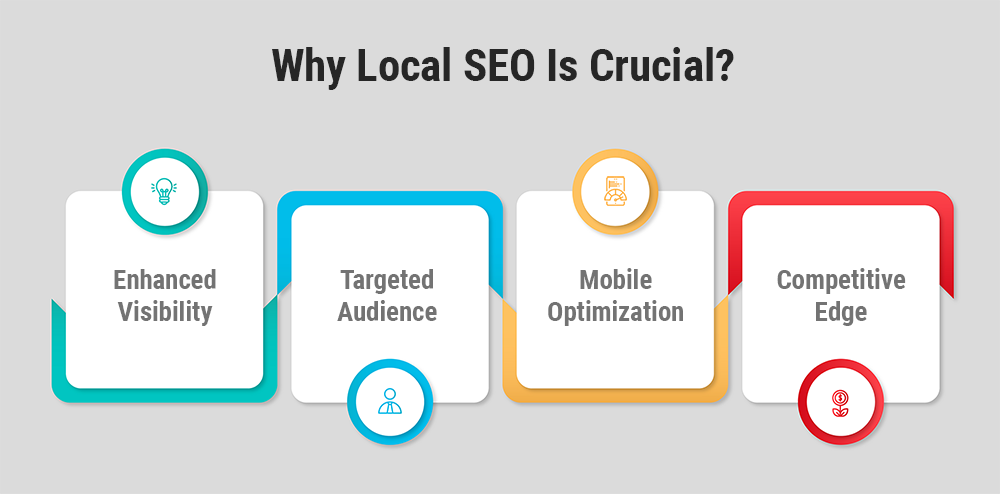
- Enhanced Visibility: A higher ranking in local search results means more people will likely see your business when searching for relevant products or services in your area. This increased visibility can lead to greater awareness of your brand among potential customers.
- Targeted Audience: Local searches often attract users actively looking to make a purchase or find a service provider nearby. By appearing in local search results, you can attract this specific audience that is more inclined to convert into customers, increasing the effectiveness of your marketing efforts.
- Mobile Optimization: With the growing use of smartphones and other mobile devices, more people are searching on the go. Local SEO ensures that your business is visible in mobile search results, allowing you to reach potential customers even when they use their mobile devices to find businesses nearby.
- Competitive Edge: Ranking higher than your competitors in local search results gives you an advantage in your area. When potential customers search for similar products or services, they are more likely to choose your business if it appears at the top of the search results, potentially leading to increased sales and market share.
Identifying Your Target Areas With Cmap
A common mistake many businesses make is optimizing solely for their city without considering the surrounding areas. This limits their potential reach. To overcome this, start by using a tool like Cmap. Here’s how:
- Visit the Cmap Website: Access the Cmap website to utilize its tools for creating detailed maps.
- Draw a Radius: Once on the Cmap website, locate the tool that allows you to draw a radius around a specific point. Enter your business location and draw a 10 km radius around it. This step helps you visualize the geographic area that encompasses potential customers. For example, if your business is in Tampa, you can see all the areas within a 10 km radius of your location.
- List Surrounding Cities: After drawing the radius, identify all the cities and neighborhoods within this boundary. Make a thorough list of these locations. For Tampa, this could include Jackson Heights and other nearby areas. This comprehensive list is crucial for targeting your marketing efforts and ensuring you reach all potential customers in your vicinity.
By identifying these target areas, you expand your marketing reach beyond just your immediate city. This broader focus helps you tap into a larger customer base in your local region, significantly increasing your potential customer reach. Instead of limiting your business to the immediate vicinity, you can strategically target surrounding cities and neighborhoods, maximizing your marketing efforts and growing your customer base.
Benefits Of Expanding Your Target Area
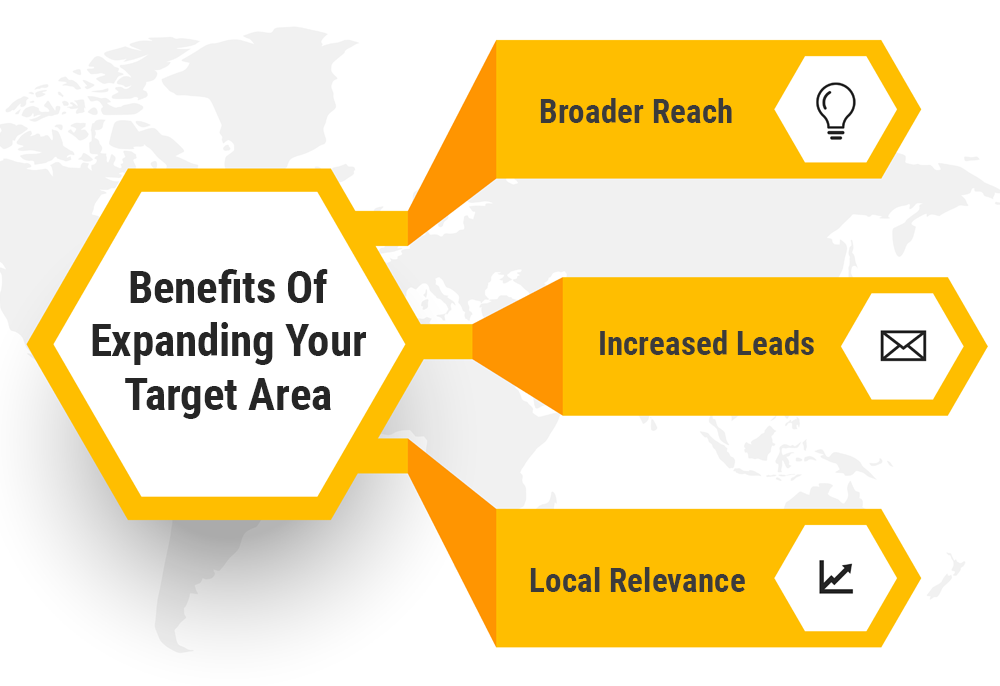
- Broader Reach: Extending your reach beyond your primary city opens up opportunities to connect with a broader audience. This involves engaging with individuals who were not initially within your target demographic. By doing so, you increase your potential customer base and market reach. This strategy allows your brand to gain visibility among diverse groups, leading to broader recognition and acceptance.
- Increased Leads: As you access a wider audience, there is likely to be a corresponding rise in leads. More interactions with your brand or product mean more potential customers entering your sales funnel. With a larger pool of leads, you have a greater chance of converting them into paying customers or clients. This increase in leads can also provide valuable insights into customer preferences and behaviors, helping you refine your marketing strategies.
- Local Relevance: Tailoring your content to each specific city or region enhances its relevance to the local audience. This can involve incorporating local references, addressing specific needs or concerns prevalent in that area, or even using language and imagery that resonate with locals. Doing so makes your brand more relatable and appealing to city residents and improves your search engine ranking for relevant local searches. This localized approach can increase engagement rates and stronger brand loyalty within different communities.
You can significantly enhance your marketing effectiveness and drive business growth by broadening your reach, increasing leads, and maintaining local relevance.
Research High-Volume Keywords With Google Ads
Once you have identified your target areas, the next crucial step is to conduct comprehensive keyword research. Utilizing tools like Google Ads can assist in identifying keywords with high monthly search volumes relevant to your services and specific locations. Here’s a detailed guide to follow:
- Set Location in GoogIn your Google Ads account, begins: Begin by setting your location to Florida, Unite account. This ensures that the keyword data you gather is relevant to your targeted geographic area.
- Search Keywords: Enter relevant search terms, such as “plumber Tampa,” into the Google Ads keyword planner. This will provide a list of related keywords along with their search volumes.
- Analyze Results: Review the keyword data to identify which terms have the highest search volumes. Pay attention to those that are most relevant to your business.
Incorporating these high-volume keywords into your content will help attract potential customers by targeting the terms they are actively searching for, thus improving your visibility and search engine ranking.
Importance Of Keyword Research
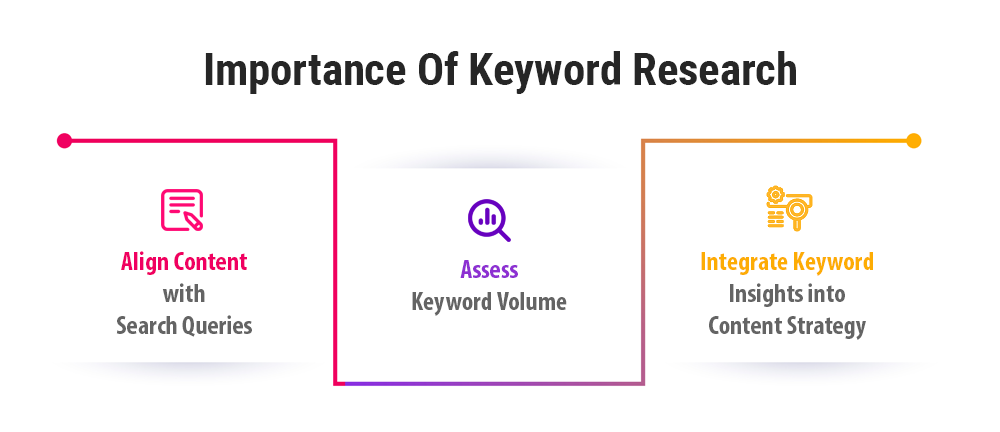
- Align Content with Search Queries: Effective content must reflect what potential customers are actively searching for. You can tailor your content to meet their needs and interests by researching and understanding their search queries. This alignment boosts the chances of your content being found and increases the likelihood of audience engagement.
- Assess Keyword Volume: Keyword volume refers to the number of searches for a particular keyword within a given timeframe. By analyzing this metric, you can gauge how competitive a keyword is in your industry. Knowing the keyword volume helps you identify which keywords are worth targeting. High-volume keywords might be competitive, but they also indicate a strong interest, which could lead to higher traffic if you rank for them.
- Integrate Keyword Insights into Content Strategy: Incorporate findings from your keyword analysis into your content strategy. By prioritizing topics with high relevance and significant search volume, you ensure your content efforts align with what your audience is looking for. This strategic focus increases the chances of finding your content, driving meaningful engagement and achieving desired outcomes.
Overall, aligning content with search queries, understanding keyword volume, and integrating these insights into your strategy is crucial to optimizing your content to reach and engage your target audience.
Analyze Competitor Websites With Ubersuggest
To optimize your content and achieve better search rankings, follow these detailed steps:
- Competitor Search: Use Ubersuggest to search for keywords relevant to your industry. For example, if you are a plumber in Tampa, search for “plumber Tampa.” Identify the top-ranking competitors in your niche.
- Content Structure Analysis: Once you have identified these competitors, analyze their websites’ structure. Pay attention to:
- Headings (H1, H2, etc.): Note how they use headings to organize their content. Headings help with SEO and improve readability.
- Word Count: Check the word count of high-ranking pages. Longer content often performs better in search results but must be high-quality and relevant.
- Keyword Usage: Identify the keywords they frequently use and where they place them (e.g., in headings, meta descriptions, or throughout the content).
- Technical SEO Evaluation: Use Ubersuggest to perform a technical analysis of your competitors’ websites. Key factors to examine include:
- Site Speed: A fast-loading website enhances user experience and is favored by search engines.
- Mobile-Friendliness: Ensure the website is optimized for mobile devices, as a significant portion of traffic comes from mobile users.
- Backlink Profiles: Analyze the quantity and quality of backlinks pointing to competitors’ sites. High-quality backlinks from reputable sites can significantly boost search rankings.
- Strategy Implementation: Based on your analysis, implement the following changes to your website:
- Content Improvement: Organize your content similarly to top-ranking sites, using effective headings and targeting relevant keywords.
- Technical Enhancements: Improve your site speed, ensure mobile optimization, and develop a strategy to acquire high-quality backlinks.
By carefully analyzing and replicating the strategies of successful competitors, you can refine your own SEO tactics, fill in any gaps, and potentially achieve higher search rankings.
What To Look For In Competitor Analysis
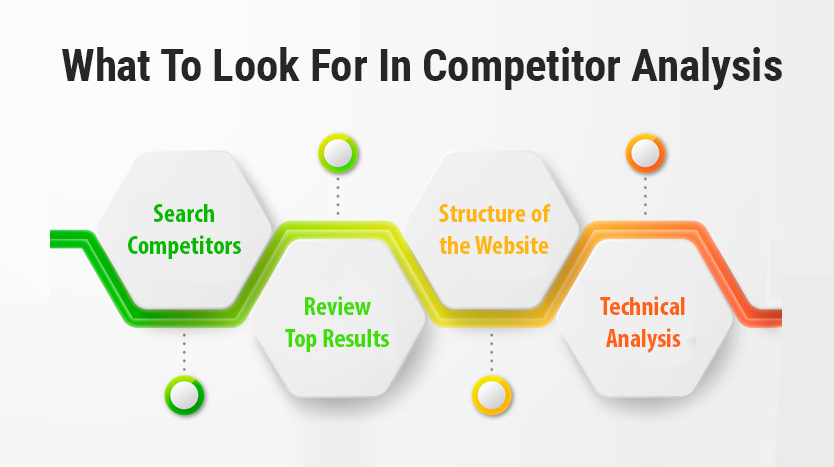
To achieve high search rankings, conduct a thorough analysis of your competitors’ websites. Utilize tools like Ubersuggest to gain detailed insights into their SEO strategies, enabling you to understand what makes their sites successful.
- Search Competitors: Start by searching for relevant keywords that are pertinent to your business, such as “plumber Tampa.” Using Ubersuggest, identify the top-ranking competitors in your niche. This step will help you understand your main competitors and what keywords drive traffic to their sites.
- Review Top Results: Once you have identified the top competitors, examine their highest-ranking websites in detail. Focus on various elements that contribute to their SEO success, including:
- Structure: Analyze the overall layout and structure of their websites. Look at how they organize their pages and navigate users through their content.
- Headings (H1, H2, etc.): Pay attention to how they use headings to structure their content. Headings help search engines understand the hierarchy and relevance of the content.
- Word Count: Take note of the length of their content. Longer, more detailed content often performs better in search rankings.
- Keywords: Identify which keywords they emphasize in their content. This will help you understand which terms are most effective for ranking in your industry.
- Technical Analysis: Use Ubersuggest to perform a technical analysis of your competitors’ websites. Evaluate critical technical SEO factors, such as:
- Site Speed: Assess how quickly their websites load. Faster sites provide a better user experience and tend to rank higher in search results.
- Mobile-Friendliness: Ensure their websites are optimized for mobile devices. With the increasing use of mobile for web browsing, mobile-friendliness is a key ranking factor.
- Backlink Profiles: Examine the quality and quantity of backlinks pointing to their sites. High-quality backlinks are essential for improving domain authority and search rankings.
By thoroughly understanding the strategies and techniques used by successful competitors, you can adopt and enhance these practices to improve your own SEO performance. This comprehensive approach will help you identify gaps and weaknesses in your current strategy and implement effective changes. As a result, you will be better positioned to achieve higher search rankings and attract more organic traffic to your site.
Optimize Your Website Content
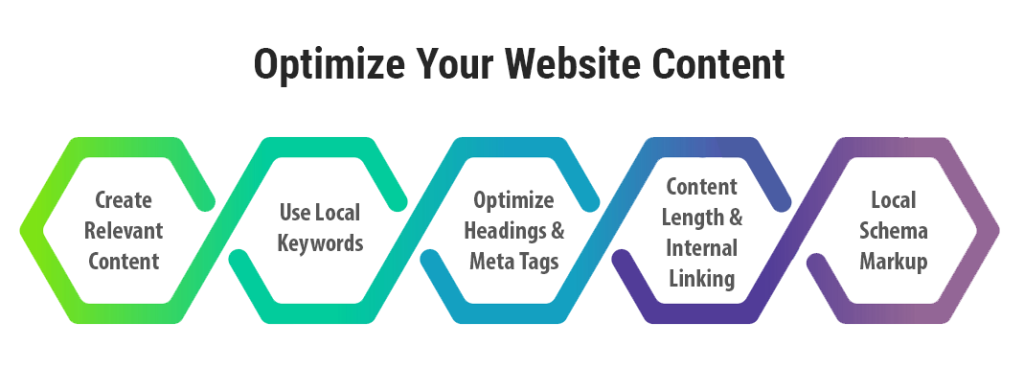
- Create Relevant Content: Start by identifying high-volume keywords from your research that align with your audience’s interests. Develop content that directly addresses these interests, ensuring it answers common questions and provides valuable information. This relevance not only attracts more visitors but also keeps them engaged.
- Use Local Keywords: Incorporate local keywords naturally within your content. For example, if you run a bakery in New York, use phrases like “best bakery in New York” or “New York artisan bread.” This approach makes your website more likely to appear in local search results, driving traffic from users in your specific geographic area.
- Optimize Headings and Meta Tags: Your primary keywords should be strategically placed in your headings (H1, H2, etc.) and meta tags (title, description). This helps search engines quickly understand the main topics of your content, improving your chances of ranking well for those keywords.
- Content-Length: Aim for at least 1000 words per page to ensure your content is comprehensive and detailed. Longer articles generally provide more value, cover topics in greater depth, and are favored by search engines for their thoroughness, potentially leading to higher rankings.
- Internal Linking: Use internal links to guide visitors to other parts of your website. For instance, within a blog post about baking techniques, link to a related page about recipes or ingredients. This improves navigation and helps distribute page authority across your site, enhancing overall SEO.
- Add Local Schema Markup: Schema markup is a form of microdata that you can add to your HTML to improve the way search engines read and represent your page in SERPs. For local businesses, include local business schema to provide search engines with information such as your business name, address, phone number, and operating hours. This can boost your visibility in local search results.
By following these optimization strategies, you can enhance your website’s relevance, improve its search engine ranking, and attract a more targeted audience.
Creating City-Specific Pages
To effectively capture local traffic and improve SEO, create individual landing pages for each city within a 10 km radius where your services are offered. For instance:
- Plumber in Jackson Heights: Create a page that focuses on plumbing services specific to Jackson Heights. Highlight common issues faced by residents, such as older infrastructure or specific plumbing codes. Use keywords like “Jackson Heights plumbing services,” “plumbers in Jackson Heights,” and “Jackson Heights emergency plumber.”
- Plumber in Oak Drive: Similarly, design a page tailored for Oak Drive. Address the unique plumbing concerns of this area, possibly focusing on newer homes or particular types of plumbing installations. Use terms like “Oak Drive plumbing experts,” “Oak Drive local plumber,” and “emergency plumbing Oak Drive.”
Each landing page should provide detailed, unique content that speaks directly to the residents’ needs. Discuss local problems and offer solutions, ensuring the use of localized keywords to match the search behaviors of potential customers. This will enhance your local search visibility and the overall effectiveness of your services in each specified location.
Importance Of Quality Content
- Retains Visitors: High-quality content ensures that visitors stay on your site for longer durations, increasing engagement and reducing bounce rates.
- Establishes Authority: Providing informative content positions you as a knowledgeable and credible source in your field, enhancing your reputation and trustworthiness.
- Improves Search Engine Rankings: Search engines prioritize well-written and comprehensive content, which can boost your site’s visibility and ranking in search results.
Enhance Your Google Business Profile
A well-optimized Google Business Profile (GBP) is essential for local SEO. Follow these steps to ensure your profile is effective:
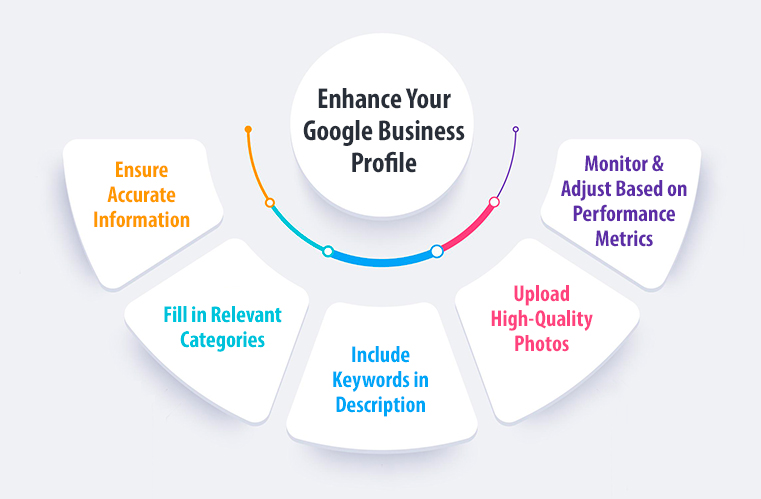
- Ensure Accurate Information: Verify that all information on your GBP is accurate. This includes your business name, address, phone number, and website. Accurate information ensures customers can find and contact you easily and helps build trust with your audience.
- Fill in Relevant Categories: Choose both primary and secondary categories that accurately describe your business. These categories help Google understand what your business is about, making it easier for potential customers to find you when searching for related services or products.
- Include Keywords in Description: Write a clear and concise business description, including your primary keyword in the first line. For example, you might say, “Page Traffic is a leading SEO company based in Delhi.” This helps improve your visibility in search results related to your business.
- Upload High-Quality Photos: Regularly upload high-quality photos to your profile. Visual content attracts more customers and provides a better sense of what to expect from your business. This can include photos of your products, services, staff, or the interior and exterior of your business location.
- Monitor and Adjust Based on Performance Metrics: Track your GBP performance metrics, such as the number of calls, messages, website clicks, and requests for directions. Analyze this data regularly and adjust your strategies accordingly to improve your visibility and engagement. This might involve updating your profile, adding new photos, or tweaking your description and categories.
By following these steps, you can create a comprehensive and attractive Google Business Profile that enhances your local SEO efforts and draws more customers to your business.
Detailed Optimization Tips
- Business Name: Ensure your business name is consistent across all online platforms to help create a strong, recognizable brand. When customers see the same name on your website, social media profiles, and online directories, they are more likely to remember and trust your business.
- Address: Accurate address information is crucial for local search engine optimization (SEO). When your address matches Google Maps, it improves your business’s chances of appearing in local search results and helps customers find you easily.
- Phone Number: A local phone number not only makes your business appear more established in the community but also enhances local SEO. Search engines often prioritize businesses with local contact information, making it easier for potential customers in your area to find your services.
- Website URL: A correct website URL ensures that potential customers are directed to the intended content without encountering errors or broken links. This improves user experience and can lead to higher engagement and conversion rates on your site.
- Hours of Operation: Regularly updating your hours of operation is essential, especially during holidays, special events, or temporary closures. Accurate hours help manage customer expectations and can prevent frustration caused by unexpected closures or changes.
- Business Description: Your business description is a critical component of your online presence. Including relevant keywords helps improve your search engine ranking, making it easier for potential customers to find you. The initial characters of your description are particularly impactful as they form the first impression in search results.
- Attributes: Utilizing attributes such as “wheelchair accessible” or “free Wi-Fi” provides valuable information to potential customers and can influence their decision to choose your business over competitors. Highlighting these features can attract a broader audience and meet the specific needs of different customer groups.
Adding And Managing Photos
- Exterior Photos: Capture clear images of your business’s exterior to give viewers a visual representation of its appearance. These photos help customers identify your establishment easily when they approach it. Highlight key features, such as signage and entrance points, for better recognition.
- Interior Photos: Photograph the atmosphere and layout of your business’s interior spaces. These images offer potential customers a glimpse into the ambiance and setup, helping them envision visiting in person. Focus on areas where customers will spend most of their time, and ensure the photos are well-lit and inviting.
- Product Photos: Showcase your products or services with high-quality images that highlight their features and benefits. These photos visually represent what you offer, enabling customers to understand the range of products or services available. Capture the products from multiple angles and include close-ups of important details.
- Team Photos: Introduce your team members with photographs that showcase their personalities and roles within the organization. These images add a personal touch to your business, allowing customers to connect with the people behind the products or services they are interested in. Include both formal headshots and candid shots to reflect the team’s dynamics.
Monitoring And Responding To Reviews
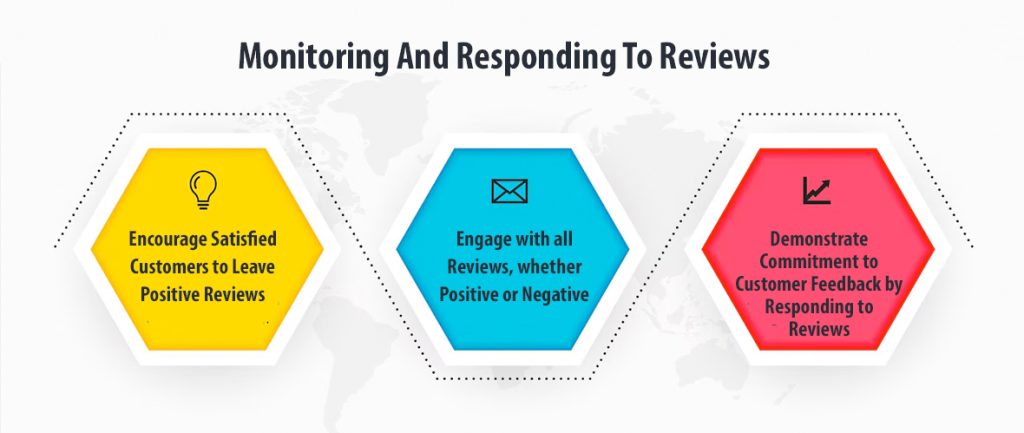
- Encourage satisfied customers to leave positive reviews: After completing a purchase or service, kindly request satisfied customers to share their experience by leaving a review. This could be through follow-up emails, thank-you notes, or in-person requests.
- Engage with all reviews, whether positive or negative: Monitor review platforms regularly to stay updated on customer feedback. When a review is posted, take the time to read and understand it. Respond promptly to show that you value their input, regardless of whether the review is positive or negative.
- Demonstrate your commitment to customer feedback and improving their experience by responding to reviews: Craft thoughtful responses to reviews, expressing gratitude for positive feedback and addressing concerns raised in negative reviews. Clearly communicate how you are taking steps to address any issues mentioned, showing that customer satisfaction is a top priority.
Building Citations And Backlinks
Citations and backlinks are crucial components of local SEO. Citations are mentions of your business name, address, and phone number (NAP) on other websites, while backlinks are links from other websites to yours.
Building Citations
Include your business information in local online directories such as Yelp, Yellow Pages, and local chambers of commerce. This ensures potential customers in your area can easily find you. Additionally, explore industry-specific directories relevant to your business niche. Listing in these specialized directories helps you reach your target audience more effectively.
Ensure consistency in your NAP (Name, Address, Phone number) across all directories. Consistent information helps search engines identify and list your business accurately, enhancing online visibility and credibility.
Having your business listed in local online directories like Yelp and Yellow Pages is crucial. These platforms are widely used by people looking for local services, making them ideal for increasing your visibility to potential customers in your vicinity. Similarly, local chambers of commerce often have their directories, which can add another layer of local exposure.
Beyond general directories, it’s beneficial to get listed in directories that cater specifically to your industry. For example, being listed in food-related directories can attract more targeted traffic if you run a restaurant. These industry-specific platforms help you connect with an audience already interested in your type of business, increasing the likelihood of attracting genuine leads.
Finally, maintaining consistency in your NAP (Name, Address, Phone number) information across all these directories is vital. When your business details are consistent, search engines can easily verify your business information, which helps in ranking your business higher in search results. This not only improves your visibility but also builds trust with potential customers who find your accurate and consistent details online.
Also Read: Mastering Local Backlinks: A Step-by-Step Guide
Building Backlinks
- Partner with local businesses to gain website mentions. Write guest posts for local blogs with backlinks. Distribute press releases to local news outlets and sponsor events for online visibility.
- Compose posts for local or industry blogs to establish authority and engage their audience. Including backlinks in posts increases website traffic and improves search engine visibility.
- Press releases effectively share business updates with the local community, such as new products, events, or milestones, enhancing media coverage and brand visibility. Distributing releases to local news outlets expands reach and attracts journalistic interest.
- Sponsoring local events boosts community support and business exposure. Partner with festivals, charity events, or industry conferences to reach target audiences and create positive brand associations. Benefits include logo placement, website mentions, and onsite promotion.
Importance Of Citations And Backlinks
- Improves Credibility: Citations and backlinks enhance your business’s credibility by indicating trustworthiness to search engines, making it more likely for your website to be considered a reliable source of information.
- Boosts Rankings: These signals help improve your search engine rankings by establishing your business as reputable and relevant, increasing the chances of appearing higher in search results.
- Drives Traffic: Citations and backlinks can drive direct traffic to your website, as users following these links are directed to your site, potentially increasing your audience and customer base.
Mobile Optimization
To ensure optimal performance for local SEO amidst the rising prevalence of mobile searches, it’s crucial to have a website optimized for mobile devices. Here are the key steps to achieve mobile-friendliness:
- Responsive Design: Incorporate a responsive design into your website development. This involves creating a layout that dynamically adjusts and rearranges content to suit different screen sizes and resolutions, ensuring an optimal viewing experience across various devices, including smartphones and tablets.
- Fast Loading Speed: Improve your website’s loading speed on mobile devices by optimizing images and minimizing unnecessary code. Compressing images without compromising quality and reducing the overall file size of web pages can significantly enhance loading times, preventing users from experiencing frustrating delays when accessing your site on their mobile devices.
- Easy Navigation: Simplify navigation on your mobile website to enhance user experience. Ensure that menus, buttons, and links are easily accessible and intuitive for smaller screens. Streamline the navigation structure and prioritize essential information to help users find what they’re looking for quickly and efficiently, minimizing the need for excessive scrolling or zooming.
- Clickable Phone Numbers: Enable clickable phone numbers on your mobile website to facilitate direct communication with your business. Making phone numbers clickable allows users to initiate calls with a single tap, eliminating the hassle of manual entry and encouraging immediate engagement.
By implementing these strategies, you can optimize your website for mobile users, enhancing its visibility, usability, and overall performance in local search engine results.
Importance Of Mobile Optimization
- User Experience: Improving the user experience is crucial for mobile visitors as it significantly influences their satisfaction and engagement with the website.
- Search Rankings: Google’s algorithm favors mobile-optimized websites when presenting search results on mobile devices. This underscores the importance for businesses to ensure their sites are optimized for mobile viewing.
- Increased Engagement: Websites that are properly optimized for mobile devices often observe greater engagement from mobile users, resulting in extended browsing sessions and possibly higher conversion rates.
Regularly Monitor And Adjust Your SEO Strategy
Local SEO is not a one-time task but an ongoing process. Continuously monitor your performance and make necessary adjustments.
Tools For Monitoring
- Google Analytics allows for the monitoring of website traffic, user behavior, and conversion rates. It provides insights into how visitors interact with a website and where they come from, aiding in the assessment of marketing strategies and website performance.
- Google Search Console aids in monitoring search performance by providing data on how a website appears in Google search results. It identifies issues such as indexing problems or website errors, allowing for their resolution to improve visibility and ranking on Google.
- Local SEO tools like Moz Local and BrightLocal assist in managing and tracking local search engine optimization efforts. They help businesses optimize their online presence for local searches, ensuring visibility to potential customers in specific geographic areas.
These tools provide features such as local keyword tracking, citation management, and local business listing optimization, contributing to improved local search rankings and increased website traffic from local audiences.
Also Read: 8 Best Local SEO Tools to Make Your Business Rank Higher in 2024
Key Metrics To Track
- Search Rankings: Track your rankings for targeted keywords.
- Traffic: Monitor the amount and quality of traffic coming to your site.
- Engagement: Measure user engagement metrics like bounce rate, time on site, and pages per session.
- Conversions: Track how many visitors are converting into customers.
Making Data-Driven Adjustments
- Analyze Data: Use the data from the tools to understand what’s working and what isn’t.
- Adjust Strategies: Based on your analysis, refine your content, optimize new pages, and keep your information up to date.
- Stay Updated: Keep abreast of the latest SEO trends and algorithm changes to adapt your strategies accordingly.
Also Read: A Complete Guide to Local SEO for New Business Owners
Advanced Local SEO Techniques
Voice Search Optimization
As voice-activated search assistants such as Siri, Alexa, and Google Assistant gain prominence, the significance of optimizing for voice search grows.
To enhance optimization:
- Utilize natural language and long-tail keywords within your content. This facilitates alignment with how users verbally articulate their queries.
- Integrate a frequently asked questions (FAQ) section on your website. This serves to address prevalent inquiries users may have.
- Embed local phrases and conversational terms within your content. This aids in catering to specific geographical areas and aligning with the conversational nature of voice searches.
Leveraging Social Media
Social media can have a notable impact on your local SEO approach. Here’s how:
- Engage Locally: Connect with your local community on social media platforms. This interaction fosters relationships and builds trust within your geographical area.
- Promote Content: Utilize social media channels to share your blog posts, promotions, and upcoming events. By doing so, you can attract more visitors to your website and increase your online visibility.
- Encourage Reviews: Leverage social media to prompt satisfied customers to leave positive reviews on your Google Business Profile. Positive reviews can enhance your credibility and reputation, ultimately boosting your local search rankings.
Utilizing Google Posts
Google Posts allow you to share updates directly on your Google Business Profile, providing various communication opportunities.
- Promotions, Events, and Special Offers: Highlight your current promotions, announce upcoming events, and showcase special offers. This attracts new customers and keeps existing ones informed about your latest deals and activities.
- Service Updates and Changes: Use these posts to share important information about any changes in your services, modifications in business hours, or the introduction of new services. Keeping your customers informed ensures they have the most up-to-date information about your business.
- Audience Engagement: Engaging with your audience directly through your profile helps maintain a continuous connection with your customers. Regular updates and interactive posts build a loyal customer base by keeping them involved and interested in your business activities.
Conclusion
To master local SEO in 2024, implement a strategic approach that includes targeted keyword research, competitive analysis, and continuous optimization. Understanding how to do local SEO involves following the steps in this guide to enhance your local search visibility and attract more customers. Consistency and adaptability are crucial in learning how to do local SEO effectively. Stay updated on the latest SEO trends and adjust your strategies accordingly. By focusing on how to do local SEO, you can ensure your business remains competitive and visible in local search results.
FAQs
What role do online reviews play in local SEO?
Online reviews have a significant impact on local SEO. Positive reviews can improve your ranking in local search results, enhance your reputation, and build trust with potential customers. Google considers the quantity, quality, and frequency of reviews in its ranking algorithm. Encouraging satisfied customers to leave reviews and responding to them (both positive and negative) can boost your local SEO efforts.
How can I ensure my website is optimized for local search?
To optimize your website for local search, include your city and state in title tags, meta descriptions, headers, and content. If you have multiple locations, create specific pages for each one. Ensure your NAP (Name, Address, Phone number) is consistent across your website and all online directories. Adding a Google Map to your contact page can improve user experience and local SEO. Use local keywords and phrases throughout your website content to better match local search queries.
What is the importance of local backlinks, and how can I acquire them?
Local backlinks are crucial because they signal to search engines that your business is trusted and relevant within your community. To acquire local backlinks, partner with local businesses for cross-promotion, get listed in local directories and chambers of commerce, sponsor local events or charities, write guest posts for local blogs, and engage with local media outlets for coverage. These strategies can enhance your local SEO by increasing your website’s authority and relevance.
What are local citations, and why are they important?
Local citations are online mentions of your business’s name, address, and phone number (NAP) on websites, directories, and social platforms. They are essential because they help search engines verify the legitimacy and accuracy of your business information, improving your local search ranking. Ensure your NAP is consistent across all citations to avoid confusion and potential penalties from search engines. Consistent citations reinforce your business’s credibility and can improve your local SEO.
























